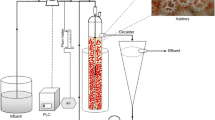Abstract
The inhibitory effect of Cd on nitrification was investigated in a continuous-flow system with enriched nitrifying bacteria. The maximum specific ammonium utilization rate and the half-saturation constant were found as 671 mg NH4–N/g VSS day and 0.48 mg/l, respectively. In the case of continuous Cd input at 1 and 2.5 mg/l, nitrification was inhibited by 30% and 47%, respectively. Inhibition ranged from 20% to 40% and no further increase in inhibition was exhibited in new runs except at 10 mg/l influent Cd. At 10 mg/l influent Cd, specific ammonium utilization and nitrate production rates were inhibited by 90%. On the contrary, a serious nitrite accumulation was not observed during this period. When Cd feeding was stopped, recovery from inhibition was observed after 37 day which was seen by the improvement in ammonium utilization and nitrate production rates. A shift in microbial population from the initial Nitrosomonas sp. to the Cd-tolerant Nitrosospira sp. was observed in the recovery period from severe Cd inhibition. After the domination of Nitrosospira species, redosing at 10 mg/l and then at 15 mg/l did not affect the performance as before.







Similar content being viewed by others
Abbreviations
- Cdbio :
-
Biosorbed Cd, mg Cd/g MLSS
- Cdvolt :
-
Labile Cd concentration in bulk solution, measured by voltammetry (Cd2+ and Cd in weak complexes), mg/l
- K I :
-
Inhibition coefficient, mg/l
- \( K_{{{\text{S}},{\text{NH}}_{4} \hbox{-} {\text{N}}}} \) :
-
Half-saturation constant for ammonium, mg/l
- qNH4–N:
-
Specific ammonium utilization rate, mg NH4–N/g VSS day
- qNO3–N:
-
Specific nitrate production rate, mg NO3–N/g VSS day
- \( q_{{\max ,{\text{NH}}_{4} - {\text{N}}}} \) :
-
Maximum specific ammonium utilization rate, mg NH4–N/g VSS day
- \( q_{{\max ,{\text{NO}}_{3} \hbox{-} {\text{N}}}} \) :
-
Maximum specific nitrate production rate, mg NO3–N/g VSS day
- \( q_{{\max ,{\text{NH}}_{4} \hbox{-} {\text{N,app}}}} \) :
-
Apparent maximum specific ammonium utilization rate, mg NH4–N/g VSS day
- S :
-
NH4–N in bulk solution, mg/l
References
APHA, AWWA, WPCF (1998) Standard methods for the examination of water and wastewater, 20th edn. American Public Health Association, Washington
Beg SA, Siddiqi RH, Ilias S (1982) Inhibition of nitrification by arsenic, chromium, and flouride. J Water Pollut Control Fed 54(5):482–488
EPA (1993) Nitrogen control manual. EPA/625/R-93/010, US EPA, Washington, DC
Gernaey K, Verschuere L, Luyten L, Verstraete W (1997) Fast and sensitive acute toxicity detection with an enrichment nitrifying culture. Water Environ Res 69:1163–1169. doi:10.2175/106143097X125911
Gikas P, Romanos P (2006) Effects of tri-valent (Cr(III)) and hexa-valent (Cr(VI)) chromium on the growth of the activated sludge. J Hazard Mater B133:212–217. doi:10.1016/j.jhazmat.2005.10.023
Gökçay CF, Yetiş Ü (1991) Effect of chromium (VI) on activated sludge. Water Res 25(1):65–73. doi:10.1016/0043-1354(91)90100-5
Hu Z, Chandran K, Grasso D, Smets BF (2002) Effect of nickel and cadmium speciation on nitrification inhibition. Environ Sci Technol 36(14):3074–3078. doi:10.1021/es015784a
Hu Z, Chandran K, Grasso D, Smets BF (2004) Comparison of nitrification inhibition by metals in batch and continuous-flow reactors. Water Res 38:3949–3959. doi:10.1016/j.watres.2004.06.025
Jianlong W, Ning Y (2004) Partial nitrification under limited dissolved oxygen conditions. Process Biochem 39:1223–1229
Jönsson K, Aspichueta E, de la Sota A, la Jansen JC (2001) Evaluation of nitrification-inhibition measurements. Water Sci Technol 43(1):201–208
Lee Y-W, Ong S-K, Sato C (1997) Effects of heavy metals on nitrifying bacteria. Water Sci Technol 36(12):69–74. doi:10.1016/S0273-1223(97)00730-0
Lewandowski Z (1987) Behaviour of biological reactors in the presence of toxic compounds. Water Res 21(2):147–153. doi:10.1016/0043-1354(87)90043-1
Madoni P, Davoli D, Guglielmi L (1999) Response of SOUR and AUR to heavy metal contamination in activated sludge. Water Res 33(10):2459–2464. doi:10.1016/S0043-1354(98)00455-2
Mazierski J (1995) Effect of chromium (Cr(VI)) on the growth rate of activated sludge. Water Res 29:1479–1482. doi:10.1016/0043-1354(94)00315-X
Mertoglu B, Semerci N, Guler N, Calli B, Cecen F, Saatci A M (2008) Monitoring of population shifts in an enriched nitrifying system under gradually increased cadmium loading. doi.:10.1016/j.jhazmat.2008.03.056
Neufeld RD, Hermann ER (1975) Heavy metal removal by acclimated activated sludge. J Water Pollut Control Fed 47(2):310–329
Ren S, Frymier PD (2003) Kinetics of the toxicity of heavy metals to luminescent bacteria. Adv Environ Res 7(2):537–547. doi:10.1016/S1093-0191(02)00022-9
Schramm A, de Beer D, den van Heuvel JC, Ottengraf S, Amann R (1999) Microscale distribution of populations and activities of Nitrosospira and Nitrospira spp. along a macroscale gradient in a nitrifying bioreactor: quantification by in situ hybridization. Appl Environ Microbiol 65(8):3690–3696
Semerci N (2007) Effect of heavy metal speciation on nitrification inhibition. PhD Dissertation, Boğaziçi University, İstanbul
Semerci N, Çeçen F (2007) Importance of cadmium speciation in nitrification inhibition. J Hazard Mater 147(1):503–512. doi:10.1016/j.jhazmat.2007.01.041
Stephen RJ, Chang Y-J, Macnaughton SJ, Kowalchuk GA, leung KT, Flemming CA (1999) Effect of toxic metals on indigenous soil β-Subgroup proteobacterium ammonia oxidizers community structure and protection against toxicity by inoculated metal-resistant bacteria. Appl Environ Microbiol 65(1):95–101
Tsai YP, You SJ, Pai TY, Chen KW (2005) Effect of cadmium on composition and diversity of bacterial communities in activated sludges. Int Biodeterior Biodegradation 55:285–291. doi:10.1016/j.ibiod.2005.03.005
Tyagi RD, Couillard D, Tran FT (1991) Analysis of final settling tank in relation to control of metal inhibition in the activated sludge process. Can J Chem Eng 69:534–543
Yetiş Ü, Gökçay CF (1989) Effect of nickel (II) on activated sludge. Water Res 23(8):1003–1007. doi:10.1016/0043-1354(89)90174-7
Zarnozsky L, Derco J, Kuffa R, Drtil M (1994) The influence of cadmium on activated sludge activity. Water Sci Technol 30(11):235–242
Acknowledgement
The financial support of this study by the Research Fund of Boğaziçi University (Project No: B.A.P. 03S103), TUBITAK (Project No: ICTAG Ç067, Project No: Ç106) is gratefully acknowledged.
Author information
Authors and Affiliations
Corresponding author
Rights and permissions
About this article
Cite this article
Semerci, N., Çeçen, F. Effect of continuous Cd feeding on the performance of a nitrification reactor. Biodegradation 20, 155–164 (2009). https://doi.org/10.1007/s10532-008-9209-z
Received:
Accepted:
Published:
Issue Date:
DOI: https://doi.org/10.1007/s10532-008-9209-z




